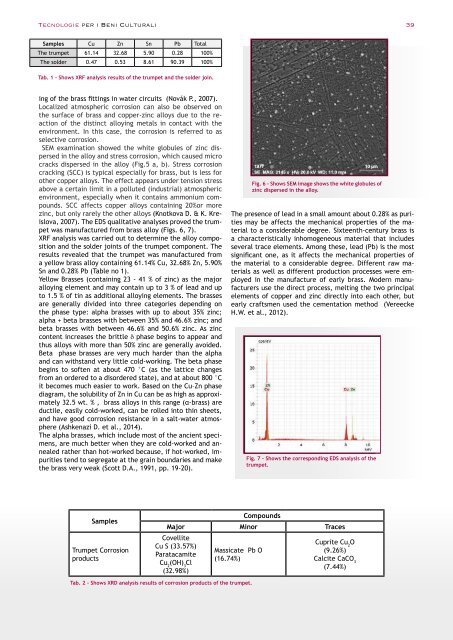Archeomatica_3_2018
Create successful ePaper yourself
Turn your PDF publications into a flip-book with our unique Google optimized e-Paper software.
Tecnologie per i Beni Culturali 39<br />
Samples Cu Zn Sn Pb Total<br />
The trumpet 61.14 32.68 5.90 0.28 100%<br />
The solder 0.47 0.53 8.61 90.39 100%<br />
Tab. 1 - Shows XRF analysis results of the trumpet and the solder join.<br />
ing of the brass fittings in water circuits (Novák P., 2007).<br />
Localized atmospheric corrosion can also be observed on<br />
the surface of brass and copper-zinc alloys due to the reaction<br />
of the distinct alloying metals in contact with the<br />
environment. In this case, the corrosion is referred to as<br />
selective corrosion.<br />
SEM examination showed the white globules of zinc dispersed<br />
in the alloy and stress corrosion, which caused micro<br />
cracks dispersed in the alloy (Fig.5 a, b). Stress corrosion<br />
cracking (SCC) is typical especially for brass, but is less for<br />
other copper alloys. The effect appears under tension stress<br />
above a certain limit in a polluted (industrial) atmospheric<br />
environment, especially when it contains ammonium compounds.<br />
SCC affects copper alloys containing 20%or more<br />
zinc, but only rarely the other alloys (Knotkova D. & K. Kreislova,<br />
2007). The EDS qualitative analyses proved the trumpet<br />
was manufactured from brass alloy (Figs. 6, 7).<br />
XRF analysis was carried out to determine the alloy composition<br />
and the solder joints of the trumpet component. The<br />
results revealed that the trumpet was manufactured from<br />
a yellow brass alloy containing 61.14% Cu, 32.68% Zn, 5.90%<br />
Sn and 0.28% Pb (Table no 1).<br />
Yellow Brasses (containing 23 - 41 % of zinc) as the major<br />
alloying element and may contain up to 3 % of lead and up<br />
to 1.5 % of tin as additional alloying elements. The brasses<br />
are generally divided into three categories depending on<br />
the phase type: alpha brasses with up to about 35% zinc;<br />
alpha + beta brasses with between 35% and 46.6% zinc; and<br />
beta brasses with between 46.6% and 50.6% zinc. As zinc<br />
content increases the brittle d phase begins to appear and<br />
thus alloys with more than 50% zinc are generally avoided.<br />
Beta phase brasses are very much harder than the alpha<br />
and can withstand very little cold-working. The beta phase<br />
begins to soften at about 470 °C (as the lattice changes<br />
from an ordered to a disordered state), and at about 800 °C<br />
it becomes much easier to work. Based on the Cu–Zn phase<br />
diagram, the solubility of Zn in Cu can be as high as approximately<br />
32.5 wt. % , brass alloys in this range (α-brass) are<br />
ductile, easily cold-worked, can be rolled into thin sheets,<br />
and have good corrosion resistance in a salt-water atmosphere<br />
(Ashkenazi D. et al., 2014).<br />
The alpha brasses, which include most of the ancient specimens,<br />
are much better when they are cold-worked and annealed<br />
rather than hot-worked because, if hot-worked, impurities<br />
tend to segregate at the grain boundaries and make<br />
the brass very weak (Scott D.A., 1991, pp. 19-20).<br />
Fig. 6 - Shows SEM image shows the white globules of<br />
zinc dispersed in the alloy.<br />
The presence of lead in a small amount about 0.28% as purities<br />
may be affects the mechanical properties of the material<br />
to a considerable degree. Sixteenth-century brass is<br />
a characteristically inhomogeneous material that includes<br />
several trace elements. Among these, lead (Pb) is the most<br />
significant one, as it affects the mechanical properties of<br />
the material to a considerable degree. Different raw materials<br />
as well as different production processes were employed<br />
in the manufacture of early brass. Modern manufacturers<br />
use the direct process, melting the two principal<br />
elements of copper and zinc directly into each other, but<br />
early craftsmen used the cementation method (Vereecke<br />
H.W. et al., 2012).<br />
Fig. 7 - Shows the corresponding EDS analysis of the<br />
trumpet.<br />
Samples<br />
Trumpet Corrosion<br />
products<br />
Compounds<br />
Major Minor Traces<br />
Covellite<br />
Cu S (33.57%)<br />
Paratacamite<br />
Cu 2<br />
(OH) 3<br />
Cl<br />
(32.98%)<br />
Massicate Pb O<br />
(16.74%)<br />
Cuprite Cu 2<br />
O<br />
(9.26%)<br />
Calcite CaCO 3<br />
(7.44%)<br />
Tab. 2 - Shows XRD analysis results of corrosion products of the trumpet.


















